RBSE Class 11 Biology Important Questions Chapter 13 Photosynthesis in Higher Plants
Rajasthan Board RBSE Class 11 Biology Important Questions Chapter 13 Photosynthesis in Higher Plants Important Questions and Answers.
RBSE Class 11 Biology Chapter 13 Important Questions Photosynthesis in Higher Plants
Multiple Choice Type Questions
Question 1.
Oxidative phosphorylation found in:
(a) chloroplast
(b) mitochondria
(c) peroxisome
(d) centriole
Answer:
(d) centriole

Question 2.
When ATP converts into ADP, then:
(a) energy releases
(b) energy absorbed
(c) enzyme forms
(d) none of these
Answer:
(d) none of these
Question 3.
Total of ATP formed between EMP path of oxygen:
(a) 24 ATP
(b) 8 ATP
(c) 38 ATP
(d) 6 ATP
Answer:
(d) 6 ATP
Question 4.
Match the statement and select correct object:
|
(A) Founder of C4 cycle |
(1) Warburg |
|
(B) Discoverer of photophosphorylation |
(2) Blackman |
|
(C) Founder of C3 cycle |
(3) Calvin and Benson |
|
(D) Proposed law of limiting factor. |
(4) Arnon |
|
(E) Experiment of Chlorella |
(5) Hatch and Slack |
(a) A (1), B (2), C (3), D (4), E (5)
(b) A (5), B (4), C (3), D (2), E (1)
(c) A (1), B (2), C (3), D (5), E (4)
(d) A (5), B (1), C (3), D (2), E (4)
Answer:
(a) A (1), B (2), C (3), D (4), E (5)
Question 5.
Which pair is not correct?
(a) C3 - maize
(b) Calvin cycle - PGA
(c) Hatch - slack cycle - OAA
(d) C4 - Kranz anatomy
Answer:
(a) C3 - maize
Question 6.
Which one is C4 plant?
(a) Onion
(b) Amaranthus
(c) Potato
(d) Mustard
Answer:
(b) Amaranthus
Question 7.
First electron acceptor in photoact - I is:
(a) airon sulphur protein
(b) ferridoxin
(c) cytochrome
(d) plastocyanin
Answer:
(b) ferridoxin
Question 8.
O2 released in photosynthesis, from:
(a) CO2
(b) Water
(c) ATP
(d) Food
Answer:
(c) ATP

Question 9.
Calvin cycle is found in:
(a) chloroplast
(b) mitochondria
(c) Golgi body
(d) nucleus
Answer:
(c) Golgi body
Question 10.
The reaction centre in photoact - I is:
(a) P - 680
(b) P - 700
(c) P - 650
(d) P - 670
Answer:
(c) P - 650
Question 11.
Which does not occur during light reaction?
(a) Photolysis of water
(b) release of H2
(c) release of O2
(d) electron transport
Answer:
(b) release of H2
Question 12.
In C3 plants the first stable product of dark reaction of photosynthesis is:
(a) malic acid
(b) oxaloacetic acid
(c) phosphoglyceraldehyde
(d) phosphoglyceric acid
Answer:
(a) malic acid
Question 13.
Chromatophores takes part in:
(a) movement
(b) respiration
(c) photosynthesis
(d) growth
Answer:
(d) growth
Question 14.
Quantasomes are found in:
(a) chloroplast
(b) mitochondria
(c) Golgi body
(d) lysosome
Answer:
(c) Golgi body

Question 15.
In photosynthesis the light independent reactions takes place at:
(a) photosystem II
(b) stromal matrix
(c) thylakoid lumen
(d) photosystem I
Answer:
(d) photosystem I
Question 16.
Which of the following organelle is related to photorespiration?
(a) Ribosome
(b) Peroxisome
(c) Glyoxysome
(d) Lysosome
Answer:
(d) Lysosome
Question 17.
The oxygen evolved during photosynthesis comes from water molecule. Which one of the following pairs of elements is involved in this reaction?
(a) Magnesium and Molybdenum
(b) Magnesium and Chlorine
(c) Manganese and Chlorine
(d) Manganese and Potassium
Answer:
(c) Manganese and Chlorine
Question 18.
Optimum temperature for photosynthesis is:
(a) 10 - 15°C
(b) 20 - 25°C
(c) 25 - 30°C
(d) 35 - 40°C
Answer:
(d) 35 - 40°C
Question 19.
The substrate for photorespiration is:
(a) pyruvic acid
(b) acetyl coenzyme - A
(c) glycolate
(d) glucose
Answer:
(b) acetyl coenzyme - A
Question 20.
Anoxygenic photosynthesis is characteristic of:
(a) Ulva
(b) Rhodospirillum
(c) Spirogyra
(d) Chlamydomonas
Answer:
(d) Chlamydomonas
Question 21.
Which of the following is associated with electron transport in photosynthesis?
(a) Sodium
(b) Potassium
(c) Iron
(d) Cobalt
Answer:
(a) Sodium
Question 22.
The main limiting factor in photosynthesis is:
(a) Water
(b) O2
(c) CO2
(d) N2
Answer:
(b) O2
Question 23.
Who proposed the law of limiting factor?
(a) Leibig
(b) Blackman
(c) Calvin
(d) Arnon
Answer:
(a) Leibig
Question 24.
The enzyme fixing CO2 in C4 plant is:
(a) PEP carboxylase
(b) RuBP carboxylase
(c) RuBP oxylase
(d) ligase
Answer:
(b) RuBP carboxylase
Question 25.
RuBP is found in:
(a) ETS
(b) Calvin cycle
(c) C4 plants
(d) Kreb's cycle
Answer:
(c) C4 plants
Question 26.
Cyclic photophosphorylation takes place in:
(a) photo act - I
(b) photo act - II
(c) Both (a) and (b)
(d) Calvin - cycle
Answer:
(b) photo act - II

Question 27.
The process of photosynthesis is:
(a) reductive, exergonic and catabolic
(b) reductive, endergonic and catabolic
(c) reductive, exergonic and anabolic
(d) reductive, endergonic and anabolic
Answer:
(a) reductive, exergonic and catabolic
Question 28.
Hill reaction is occurs in:
(a) high altitude plant
(b) total darkness
(c) absence of water
(d) presence of ferricyanide
Answer:
(c) absence of water
Question 29.
The photorespiration in C3 plants, starts with:
(a) phosphoglycerate
(b) phosphoglycolate
(c) glycerate
(d) glycine
Answer:
(c) glycerate
Question 30.
Both PS - I and PS - II are found in:
(a) Purple sulphur bacteria
(b) Green sulphur bacteria
(c) Cyanobacteria
(d) Purple non - sulphur bacteria
Answer:
(c) Cyanobacteria
Question 31.
The energy obtained from light reaction in photosynthesis is transferred to dark reaction in the form of:
(a) ADP
(b) ATP
(c) RuBP
(d) Chlorophyll
Answer:
(c) RuBP
Question 32.
Which of the following takes part in photorespiration?
(a) Cytoplasm and Mitochondria
(b) Cytoplasm, mitochondria and peroxisome
(c) Cytoplasm, chloroplast and peroxisome
(d) Cytoplasm, chloroplast, peroxisome and mitochondria
Answer:
(b) Cytoplasm, mitochondria and peroxisome
Qustion 33.
The first stable compound formed in photosynthesis of C3 plants is:
(a) Phosphoglyceric acid
(b) Starch
(c) Pyruvic acid
(d) Ribulose diphosphate
Answer:
(b) Starch
Question 34.
During photosynthesis, the transfer of hydrogen from light reaction to dark reaction takes place by:
(a) DPN
(b) DNA
(c) ATP
(d) NADP
Answer:
(c) ATP
Question 35.
CAM helps plant in:
(a) secondary growth
(b) disease resistance
(c) reproduction
(d) water conservation
Answer:
(d) water conservation
Question 36.
The first reaction in photosynthesis is:
(a) photolysis of water
(b) excitation of chlorophyll molecule
(c) formation of ATP
(d) CO2 fixation
Answer:
(d) CO2 fixation
Question 37.
Kranz anatomy is characteristics for:
(a) hydrophytes
(b) xerophytes
(c) C3 plants
(d) C4 plants
Answer:
(d) C4 plants
Question 38.
C4 cycle is found in:
(a) fig
(b) mango
(c) sugarcane
(d) None of these
Answer:
(d) None of these

Question 39.
Useful ion in photosystem - II are:
(a) Mn+2 and Cl-
(b) Mg+2 and NO3-
(c) Fe+2 and Cl-
(d) K+ and Na+
Answer:
(d) K+ and Na+
Question 40.
Chloroplast which are devoid grana found in:
(a) mesophytes
(b) C3 plants
(c) C4 plants
(d) hydrophytes
Answer:
(a) mesophytes
Very Short Answer Type Questions
Question 1.
Name the algae chosen in research related to photosynthesis.
Answer:
Chlorella.
Question 2.
Name an autotrophic organism which lacks chloroplast.
Answer:
Cyanobacteria.
Question 3.
In which plants Kranz anatomy is found?
Answer:
In C4 plants.

Question 4.
Who proposed C4 cycle?
Answer:
M.D. Hatch and C.R. Slack.
Question 5.
Who proposed Z - scheme of light reaction?
Answer:
R. Hill and Bendall in 1960.
Question 6.
In which part of chloroplast, light reaction takes place?
Answer:
Grana.
Question 7.
In which part of chloroplast, dark reaction takes place?
Answer:
Stroma.
Question 8.
Write the name of two system of light reaction.
Answer:
Photo act - I and Photo act - II.
Question 9.
Name two plants in which stomata open at night.
Answer:
- Opuntia
- Agave.
Question 10.
From where is energy obtained for dark reaction?
Answer:
From ATP which is produced in light reaction.
Question 11.
Name three products of Hill reaction.
Answer:
Oxygen, ATP and NADPH2.
Question 12.
What is quantum yield?
Answer:
The number of released oxygen molecules in per quanta of absorbed light is called quantum yield.
Question 13.
Write full form of NADP.
Answer:
Nicotinamide Adenine Dinucleotide.
Question 14.
Which is CO2 acceptor in C3 plants?
Answer:
Ribulose biphosphate (RuBP).
Question 15.
Which is CO2 acceptor in C4 plants?
Answer:
Phosphoenol pyruvic acid (PEP).
Question 16.
Name any two C4 plants.
Answer:
Sugarcane, Amaranthus.
Question 17.
In which plants CAM cycle is found?
Answer:
In succulent plants.
Question 18.
What is the concentration of gaseous CO2 in atmosphere?
Answer:
0.03% to 0.04%.

Question 19.
Name any photosynthetic bacteria.
Answer:
Chlorobium.
Question 20.
In which form, the aquatic plants absorbed carbon from normal surface?
Answer:
Bicarbonates.
Question 21.
Name the enzyme which breaks ribulose - 1, 5 - biphosphate into 3 - phosphoglyceric acid and 2 - phosphoglycolic acid.
Answer:
Ribulose biphosphate oxygenase.
Question 22.
Which is most important limiting factor in photosynthesis?
Answer:
Carbon dioxide.
Question 23.
Which compound donates hydrogen to carbohydrate in Calvin cycle.
Answer:
NADPH2.
Question 24.
Which is first stable product of C4 cycle?
Answer:
Oxaloacetic acid (OAA).
Question 25.
Which pigment is present universally in all green plants?
Answer:
Chlorophyll - a.
Question 26.
What important role of light energy in photosynthesis?
Answer:
Light energy causes photolysis of water.
Question 27.
What do you mean by P - 700 and P - 680?
Answer:
P - 700 and P - 680 are special type of chlorophyll - a molecules they are called reaction centre.
Question 28.
Where does photosynthesis occur in plants?
Answer:
In chloroplast.
Short Answer Type Questions - I
Question 1.
Define photosynthesis.
Answer:
Photosynthesis: Photosynthesis is a process in which green plants manufacture carbohydrates using water and carbon dioxide, with the help of chlorophyll, in the presence of sunlight. During this process oxygen is liberated as a byproduct.

Question 2.
How do character of light affect the process of photosynthesis.
Answer:
Photosynthetic pigment can absorb the wavelength of 400 nm to 800 nm of visible spectrum. In green plants, maximum photosynthesis occurs in red light. In red algae, maximum photosynthesis occur in blue light.
Question 3.
What do you mean by red drop?
Answer:
Robert Emerson confirmed that when the plants are exposed in the wavelength of more than 680 nm (red light), then there is a reduce in quantum yield, it is called red drop.

Question 4.
Write difference between respiration and photorespiration.
Answer:
- The respiration occurs in all green plants while photorespiration found only in C3 plants.
- Glucose is used in respiration while glycolate is used in photorespiration.
Question 5.
What is solarization?
Answer:
Solarization: There is a photo oxidation of chlorophyll being started in higher intensity of light, this condition is called solarization. In this the rate of photosynthesis reduces very much.
Question 6.
What is Compensation point?
Answer:
A time period for plants of evening and morning, when there is no gaseous exchange between plants and atmosphere, i.e., due to low light intensity the rate of photosynthesis and respiration both are equal. In this time there is no exchange of O2 and CO2. It is called compensation period.
Question 7.
What do you understand by photosynthetic number?
Answer:
The quantity of CO2 absorbed by 1 gm of chlorophyll in one hour is called photosynthetic number or assimilation number. This number is usually constant for a particular plant species.
Photosynthetic number \(=\frac{\text { The absorbed quantity of } \mathrm{CO}_{2} \text { in one hour }}{1 \mathrm{gm} \text { of chlorophyll }}\)
Short Answer Type Questions - II
Question 1.
Explain following equation showing summary of chemical process of photosynthesis:

Answer:
Photosynthesis is an anabolic process. In this process atmospheric CO2 and soil water are used to manufacture glucose (sugar) with the help of chlorophyll in the presence of sunlight. In this process O2 is released as by product.
Hill (1941), Ruben and Kamen (1943) proved by their experiments that the O2 is released from photolysis of water in photosynthesis. In above equation, 6 molecules of CO2 and 12 molecules of H2O are used for manufacture of one molecule of glucose along with this 6 molecules of water and 6 molecules of O2 are released.
Question 2.
Prove by an experiment that CO2 is required for photosynthesis.
Answer:
In photosynthesis, CO2 is used for formation of carbohydrate. To know that CO2 is required for photosynthesis, Moll’s half leaf experiment can be done. A wide mouth bottle with a little of KOH solution is taken. Now one half of the leaf with the help of a split cork is inserted iri the bottle. The bottle is made air tight and the apparatus is placed in sunlight.
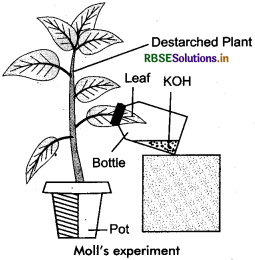
After a definite period, the leaf is detached and boiled, first in Water and later in alcohol in water bath. By doing' so, all the chlorophyll present in the leaf comes out and leaf becomes colourless. This leaf is stained with iodine solution. It is observed that the part of leaf which was enclosed within the bottle does not turn blue and the part of the leaf which was out of the bottle turns blue, indicating the presence of starch. The portion inside the bottle does not get the CO2, as it is absorbed by KOH solution. The process of photosynthesis does not occur in lack of CO2. Contrary to this, the process of photosynthesis occurs and the starch is formed in the part of leaf, which was out of the bottle because of the presence of CO2. This shows that CO2 is essential for photosynthesis.
Question 3.
How can you prove that oxygen is released during photosynthesis?
Answer:
In photosynthesis CO2 and H2O is used and O2 is released.

Experiment: Aquatic plant, Hydrilla is used for this experiment. Hydrilla is placed at the bottom of a beaker containing pond water. A pinch of sodium bicarbonate is added in water so that it (water) gets CO2. Cover the plant with an inverted funnel. Now, over ths axis of the funnel, a test tube, filled with water is kept, inverted. Now, this apparatus is placed in sunlight.
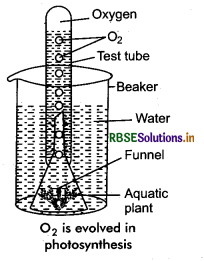
After sometime, the air bubbles are seen, coming out from the cut end of plant which collect in the test tube by downward displacement of water. These bubbles are of O2 gas. It is clear from the experiment that the process of photosynthesis occurs in Hydrilla plant, by which O2 gas is evolved.

Question 4.
How can you prove that light is essential for photosynthesis?
Answer:
An experiment is made to show that light is essential for photosynthesis. Place a potted plant for about 24 hours in dark so that the leaves become free from starch. Cover the middle part of lamina of any leaf with black paper or Ganong’s light screen and clip it with the help of a glass slide. Now, place this plant in sunlight. After a few hours, test the leaf for starch.
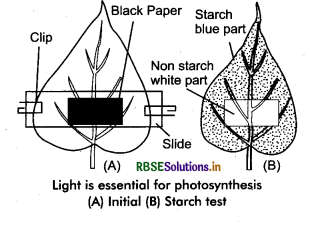
The leaf turn blue only in those part which were exposed to light and the portions which were covered with light screen or black paper will not show blue stains. It clearly indicates that light is essential for photosynthesis.
Question 5.
What is photophosphorylation?
Answer:
There H+ and OH- ions are formed by hydrolysis in the presence of sunlight, this process is called photolysis of water. Absorbing light waves or photons, the chlorophyll molecule gets excited and hydrolysis of water working as strong oxidiser. Manganese (Mn2+) and chloride (Cl-) ions play an important role in photolysis of water. The electrons released during photolysis of water received by P - 680 (PS - II). Such a way 2H+ ions produced in photolysis of water and received by NADP. O2 molecule is released from two molecules of water in this process as by product.
4H2O → 4(OH-) + 4H+
4(OH-) → 4(OH) + 4e-
2(OH) → 2H2O + O2
2H2O → O2 + 4H+ + 4e-
Photophosphorylation
The chlorophyll molecules, present in chloroplast absorb light energy in the process of photosynthesis. This energy is stored in ATP and alongwith this NADPH is formed. Arnon called it photosynthetic phosphorylation and considered ATP as assimilatory power of photosynthesis. The process of ATP formation from ADP and ip (inorganic phosphate) in the presence of sunlight is called photophosphorylation. The process of photophosphorylation occurs by various pigments present in two pigment systems. In this, there two cycles are takes part. These cycles are called cyclic and non - cyclic photo - phosphorylation.
Cyclic Photo - phosphorylation
In this process chlorophyll molecules of PS - I absorb light energy (hv) and transfer electrons to reaction centre (P - 700) of PS - I of photo - act - I. P - 700 eject 2e- absorbing light energy. After ejection of electrons it gets oxidised. The electrons ejected by P - 700 are first received by ferridoxin. From where they pass through various electron receptors; such as cyt - b6, cyt - F and plastocyanin respectively and finally return into P - 700. In this process of cyclic electron transport, ADP molecules combine with inorganic phsophate to form ATP molecule at two sites:
- At transfer of electrons from ferridoxin to cyt - b6.
- At transfer of electrons from cyt - b6 to cyt - f.
Though, in this process, electrons emitted from P - 700 molecule cycled to P - 700 molecule. Therefore this process is called cyclic photophosphorylation.
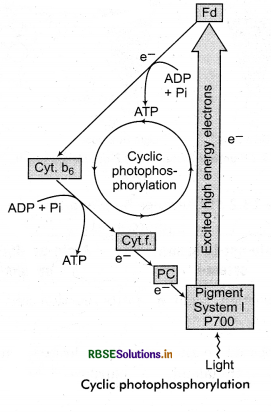
Non - Cyclic Photophosphorylation
In this process, chlorophyll molecules of both photo acts (PS - I and PS - II) take part. Electrons produced from photolysis of water received by reaction centre (P680) of PS - II. P680 transfer electrons to phaeophytin. From here, the electrons are now accepted by plastoquinone (PQ). The electrons from PQ move downhill and reaches to P700 (PS - I) through various electron carriers and compensate the deficiency of electron in P700 - molecule. Various compounds and their sequence through which the electrons are transferred and reaches to PS - I in a linear manner are as follows:
Plastoquinone (PQ) → Cytochrome b6 → Cytochrome - F → Plastocyanin (PC) → Pigment System - I (P - 700)
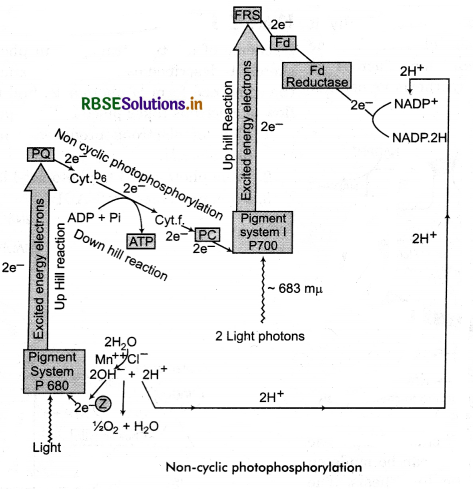
During electron transport, large amount of energy is released between cyt. b6 and cyt - f which is sufficient to convert one ADP molecule to one ATP molecule.
In the above electron transport, the electrons emitted PS - II did not return to its place of origin, instead it was passed on to PS - I. Similarly, the electrons emitted from PS - I did not cycle back, but, they were used to reduce NADP to NADPH2. Thus, this electron transport is called non cyclic electron transport and the phosphorylation as non - cyclic photophosphorylation.
Question 6.
Explain cyclic photo - phosphorylation reaction.
Answer:
Cyclic Photo - phosphorylation
In this process chlorophyll molecules of PS - I absorb light energy (hv) and transfer electrons to reaction centre (P - 700) of PS - I of photo - act - I. P - 700 eject 2e- absorbing light energy. After ejection of electrons it gets oxidised. The electrons ejected by P - 700 are first received by ferridoxin. From where they pass through various electron receptors; such as cyt - b6, cyt - F and plastocyanin respectively and finally return into P - 700. In this process of cyclic electron transport, ADP molecules combine with inorganic phsophate to form ATP molecule at two sites:
- At transfer of electrons from ferridoxin to cyt - b6.
- At transfer of electrons from cyt - b6 to cyt - f.
Though, in this process, electrons emitted from P - 700 molecule cycled to P - 700 molecule. Therefore this process is called cyclic photophosphorylation.
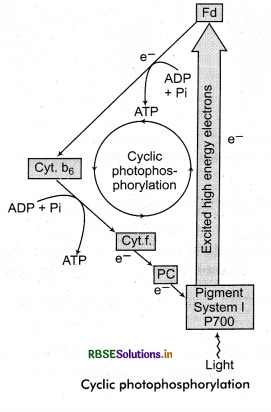
Question 7.
Explain non - cyclic photo phosphorylation.
Answer:
Non - Cyclic Photophosphorylation
In this process, chlorophyll molecules of both photo acts (PS - I and PS - II) take part. Electrons produced from photolysis of water received by reaction centre (P680) of PS - II. P680 transfer electrons to phaeophytin. From here, the electrons are now accepted by plastoquinone (PQ). The electrons from PQ move downhill and reaches to P700 (PS - I) through various electron carriers and compensate the deficiency of electron in P700 - molecule. Various compounds and their sequence through which the electrons are transferred and reaches to PS - I in a linear manner are as follows:
Plastoquinone (PQ) → Cytochrome b6 → Cytochrome - F → Plastocyanin (PC) → Pigment System - I (P - 700)
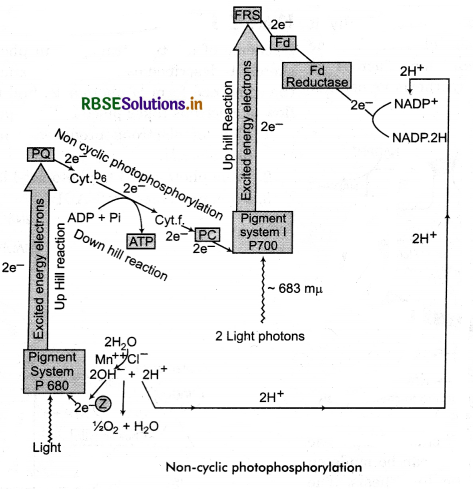
During electron transport, large amount of energy is released between cyt. b6 and cyt - f which is sufficient to convert one ADP molecule to one ATP molecule.
In the above electron transport, the electrons emitted PS - II did not return to its place of origin, instead it was passed on to PS - I. Similarly, the electrons emitted from PS - I did not cycle back, but, they were used to reduce NADP to NADPH2. Thus, this electron transport is called non cyclic electron transport and the phosphorylation as non - cyclic photophosphorylation.
Question 8.
Write short notes - “The leaves are solar receptive”.
Answer:
All green plants make their own food in the presence of sunlight. These plants contain chlorophyll in their leaves. Chloroplast has various types of pigments. These pigments absorb different wavelength of light. Therefore, the leaves are called solar receptive. The chief pigment of chloroplast is chlorophyll. It forms sugar by CO2 and water in the presence of sunlight. Only 3 - 5% part of solar energy is used in photosynthesis by the plants. Rest of light is reflected.
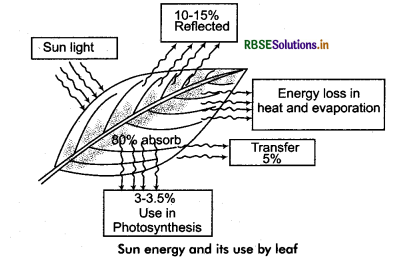

Question 9.
Differentiate between photoact - I and photoact - II.
Answer:
|
Photo - act - I/ Pigment sytem - I |
Photo - act - II / Pigment system - II |
|
1. Its reaction centre is P - 700. |
1. Its reaction centre is P - 680. |
|
2. It is located on the outer surface of thylakoid. |
2. It is located on the inner surface of thylakoid. |
|
3. It involved both in cyclic and non - cyclic photophos phorylation. |
3. It is involved only in non - cyclic photophosphory lation. |
|
4. It receives electrons from I photo - act - II. |
4. It receives electrons from photolysis of water. |
|
5. Both wavelength of light, shorter and longer than 680 nm are absorbed by it. |
5. Only wavelength of light, shorter than 680 nm are absorbed by it. |
|
6. It gives electron to NADP. |
6. It gives electron to P - 700. |
|
7. In this, the amount of chlorophyll - b and carotenoid is less. |
7. In this, the amount of chlorophyll - b and carotenoid is more. |
Question 10.
Write difference between light and dark reaction of photosynthesis.
Answer:
|
Light Recation |
Dark Reaction |
|
1. It requires light. |
1. It does not require light. |
|
2. It takes place in grana of chioroplast. |
2. It takes place in stroma of chioroplast. |
|
3. Light energy is absorbed in it and converting it into chemical energy to form ATP. It is called photophosphorylation. |
3. Energy obtained from light reaction is used in CO2 assimilation and carbohydrate is formed. |
|
4. Photolysis of water is taken place thereby O2 is produced as byproduct and H+ and e- are formed. |
4. H+ is used in reduction of CO2. |
|
5. Oxygen is released. |
5. CO2 is used. |
|
6. Pigment systems are required. |
6. Pigment systems do, not require. |
Question 11.
Give brief description of chemiosmosis hypothesis.
Answer:
According to this theory, molecules like glucose are metabolized to develop acetyl CoA in the form of an intermediate that is energy - rich. The proper oxidation of acetyl CoA occurs in the mitochondrial matrix and is combined to the reduced form of a carrier molecule namely FAD and NAD. The carriers then supply electrons to the transport chain of the electron in the inner membrane of mitochondria, which further supply them to different other proteins present in the ETC.
The energy present in the electrons is basically used to pump out protons from the matrix in the inner mitochondrial membrane. It is used for energy storage in the form of a transmembrane electrochemical gradient. The protons return to the inner membrane by the ATP enzyme synthase. The proton - flow travels into the matrix of mitochondria through ATP synthase, which gets a good amount of energy for the ADP to integrate with inorganic phosphate to produce ATP.
Question 12.
How CO2 fixation takes place in CAM plants?
Answer:
CAM means Crassulacean Acid Metabolism. It is a biochemical process found in succulent plants such as members of family crassulaceae. eg., Kalanchoe, Sedum etc., and some other plants eg., cactus, orchids, pine apple etc. Since the study of this cycle was first made in the members of family crassulaceae, hence, this cycle is called crassulacean acid metabolism (CAM). The plants in which this cycle occurs, are called CAM plants.
Mechanism of CAM Cycle: In CAM plants, stomata open at night, hence, leaves absorb CO2 during night. The phosphoenol pyruvic acid (PEP) present in the cytoplasm of mesophyll cells acts as a CO2 acceptor. It absorbs CO2 to form 4C - compound oxaloacetic acid (OAA). In turn it reduced to malic acid which remains stored in the vacuole of mesophyll cells.
During day time, the malic acid is again return to cytoplasm from the vacuole and decarboxylated to produce pyruvic acid and CO2 is evolved. This process is known as deacidification. Now the CO2 released by deacidification of malic acid reaches to chloroplast and is reduced to carbohydrates by Calvin cycle. The pyruvic acid is converted into carbohydrates and some amount of it is used in respiration.
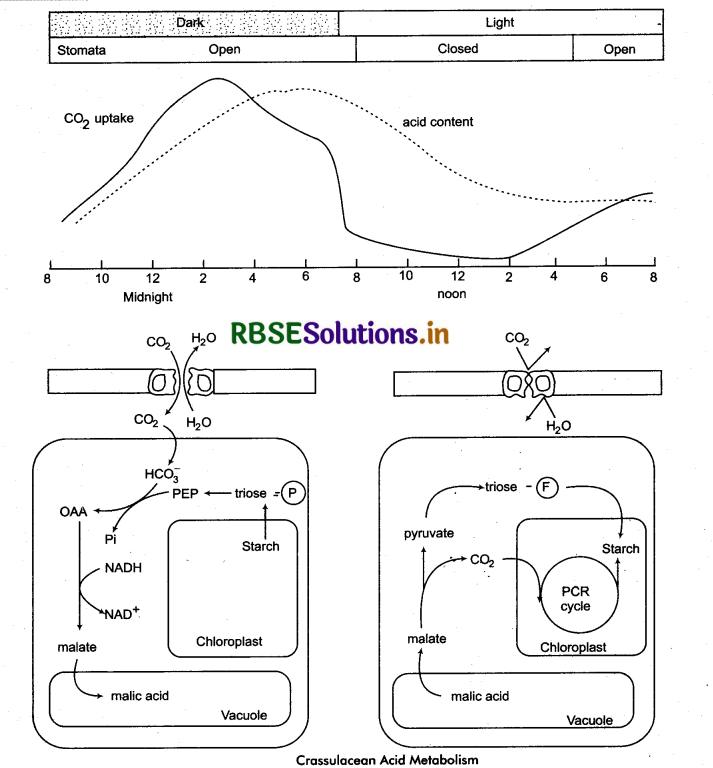
Question 13.
Give the types of C4 Plants.
Answer:
Chollet and Olgren (1975) classified C4 plants into three groups:
- First group: In these plants, PEP combine with CO2 to form OAA which forms malic acid. Malic acid is transferred to the bundle sheath cells, e.g., sugarcane, maize etc.
- Second group: In these plants, instead of malic acid, aspartic acid is transferred to bundle sheath cells which forms OAA. This OAA is converted into pyruvic acid and CO2 by the enzyme PEP carboxykinase. e.g., Panicum maximum, Chloris gayana etc.
- Third group: In Artiplex spongiosa, the aspartic acid is formed in the mesophyll cells which is transferred to bundle sheath cells and is converted to malic acid. This malic acid forms pyruvic acid and CO2 by decarboxylation.
Question 14.
Wrtie biological significance of C4 cycle.
Answer:
Biological Significance of C4 cycle: The main aim of C4 cycle is to provide sufficient concentration of CO2 in bundle sheath cells is almost ten times greater than C3 plants, whereby the rate of photosynthesis in C4 plants is increased 2 - 3 times than C3 plants. PEP has great affinity with CO2. Due to this property, C4 plants can absorb CO2 even from much low CO2 concentration. Plants can perform photosynthesis through this cycle even in low concentration of CO2 and even when the stomata are nearly closed due to very high temperature. Besides, C4 plants do not show photorespiration, hence, their photosynthesis rate is quite high.

Question 15.
Write the significance of CAM cycle.
Answer:
The significance of CAM cycle:
- In CAM plants, though stomata remain closed during day time, however the process of photosynthesis continues.
- In CAM plants, CO2 evolved during respiration can be refixed by this cycle whereas the other plants lose this CO2.
- The CAM cycle is a significant process for succulent plants which helps these plants to continue photosynthesis under extreme xeric conditions.
Long Answer Type Questions
Question 1.
Define photosynthesis? Write the mechanism of photosynthesis in brief.
Answer:
Photosynthesis: Photosynthesis is an anabolic process in which green plants synthesize complex organic substances by water and carbon dioxide with the help of chlorophyll in the presence of sunlight.

The process of photosynthesis is completed in two steps:
I. Light reaction or photochemical reaction.
II. Dark reaction or Blackman reaction.
I. First Step: Light Reaction: This process takes place in grana of chloroplast. First of all chlorophyll molecules absorb sunlight and get excited. By the sunlight there photolysis of water into H+ and OH- occurs. OH- ions combine to form water and O2. H+ ions are received by NADP+. Evolved oxygen goes to atmosphere and some of it used in photorespiration. In this process, electrons are formed which form ATP passing through various pathway. Therefore, there are three products of light reaction - ATP, NADPH2 and O2.
II. Second Step: Dark Reaction: The light is not essential for this process. It takes place in stroma of chloroplast. In this reaction sugar is formed by reduction of CO2 using ATP and NADPH2 produced in light reaction.
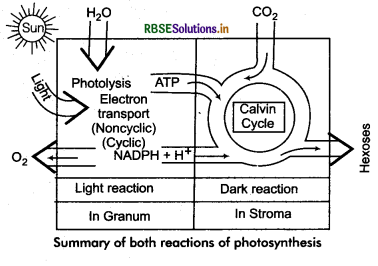
In this reaction, 5C compound ribulose - biphosphate present already in stroma, accept one molecule of CO2 and forms an unstable compound of 6 - carbon atom. Which later on breaks into 3 - C compound 3 - phosphoglyceric acid (PGA). Finally 6 - carbon compound glucose is formed using NADPH2.
Question 2.
Describe two pigment system in photosynthesis.
Answer:
Two Photosystems and Their Pigment Systems
The discovery of red drop and Emerson’s enhancement effect clearify that at least two groups of pigments are present for the absorption of light in the light reaction of photosynthesis. These groups of pigments are called Pigment System - I and pigment system - II. Pigment system - I (PS - I) works for photo act - I and pigment system - II (PS - II) works for photo act - II.
1. Photo - Act - I and its Pigment System - I
In photo - act - I, various molecules of chlorophyll - a absorb energy of photons of light, therefore, on the basis of absorption of different wavelength rays, they are of different types such as “chl - a - 660; chl - a - 670; chl - a - 680; chl - a - 690 and chl - a - 700. This system has a special type of chlorophyll - a molecule called “p - 700”, which absorbs the light rays of wavelength of 700 nm. It is the reaction centre of pigment system - I, Pigment system - I takes part in both cyclic and non cyclic photophosphorylation. In cyclic photophosphorylation, the pigment system - I takes part independently. Various chlorophyll-a molecules present around reaction centre, transfer electrons to it.
2. Photo - act - II and its pigment system - II
Pigment system - II of photo - act - II has chlorophyll - a - 660; chl - a - 670; chl - a - 678; chl - a - 680 (P - 680) and chl - b - 650. In this system chl - a - 680 (P - 680) absorbs the light rays of 680 nm. It functions as the reaction centre of pigment system - II. Other chlorophyll - a and chl - b molecules transfer their electrons to chl - 680. Pigment system - I takes part only in non - cyclic photophosphorylation.
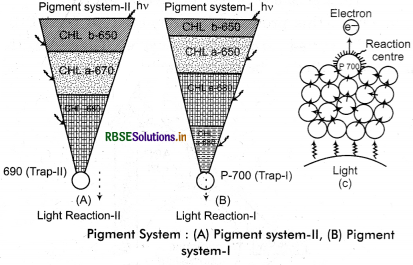
Question 3.
What is Z - scheme of electron transport in photosynthesis?
Answer:
Z - scheme of electron transport in photosynthesis is a contrived sketch. It described by Robin Hill and Fay Bendall (1960). It is the combined form of photo - act I and photo - act - II. In this, there flow of electrons takes place in three paths:
- Flow of electrons produced from hydrolysis of water to photo - act - II.
- From photo - act - II to photo - act - I and
- From photo - act - I to NADP+.
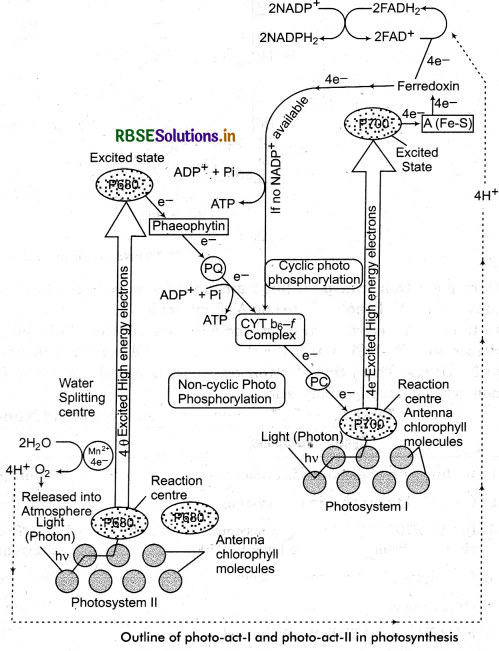
This scheme explains electron transport and production of NADPH2 and ATP in chloroplasts. As shown in figure, the P680 molecule of PS - II in photo - act - II becomes excited by absorbing photon of light. It transfers its electrons to phaeophytin. Now these electrons transferred to P - 700 molecules via PQ; cyt b6; cyt bf and PC respectively. The reduced P700 now gets excited and transfer electrons to an unknown electron acceptor called [A(Fes)]. From where electrons are transferred to FAD and finally to NADP via ferridoxin. Such a way the flow of electrons forms a 'Z' - like structure. This name (Z - scheme) is given to it after its shape.
Question 4.
Describe dark reaction with diagram.
Or
Describe Calvin cycle.
Answer:
This reaction takes place in stroma part of chloroplast. Calvin and Benson (1949) studied this cycle. They used tracer technique for the discovery of carbon path in the unicellular green algae Chlorella. By using carbon dioxide (14CO2) containing radio - active carbon, they conclude that phosphoglyceric acid (PGA; a three carbon compound) is the first stable product in photosynthesis. Calvin and Benson were jointly awarded Nobel prize in 1961 for this work. M. Calvin made further study of dark reaction in photosynthesis. Therefore, this cycle is called' Calvin cycle. As the first stable product of calvin cycle is 3C - compound (PGA), it is also called C3 cycle. The plants in which this cycle is found are called C3 - plants.
The Calvin cycle can be divided into following three major steps:
(A) Carboxylation,
(B) Reduction of phosphoglyceric acid
(C) Synthesis of hexose sugar, and
(D) Regeneration of ribulose biphosphate.
(A) Carboxylation: Combination of CO2 with any compound is called carboxylation. In this reaction, 5C - compound ribulose - 1, 5 - diphosphate or biphosphate (RuDP or RuBP), primary acceptor of CO2 in photosynthesis, combines with CO2 to form a 6C compound which is quite unstable and splits into two molecules of 3C - compound, 3 - phosphoglyceric acid. This reaction is catalysed by the enzyme ribulose diphosphate carboxylase (RuDP carboxylase or RUBISCO). This enzyme is abundantly found in all the photosynthetic cells. This enzyme is large protein molecule, which contributes 16% part of total protein present in chloroplast.
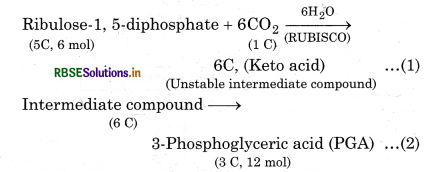
3 - C compound, phosphoglyceric acid is the first stable product of photosynthesis in several plants. These plants are called C3 - plants and this type of carbon assimilation is called C3 - cycle.
(B) Reduction of Phosphoglyceric acid: (i) 12 molecules of 3 - phosphoglyceric acid combine with 12 molecules of ATP (produced in the light reaction) to form 12 molecules of 1, 3 - diphosphoglyceric acid. This reaction is catalysed by enzyme phosphoglycerokinase.

(ii) 1, 3 - diphosphoglyceric acid reduces into 12 molecules of 3 - phosphoglyceraldehyde combining with 12 molecules of NADPH2 (produced in the light reaction). This reaction is catalysed by the enzyme triose phosphate dehydrogenase.

(iii) Of the 12 molecules of 3 - phosphoglyceraldehyde, 5 molecules are convertd into its isomer dihydroxyacetone phosphate. This isomerization is catalysed by enzyme triose phosphate isomerase.

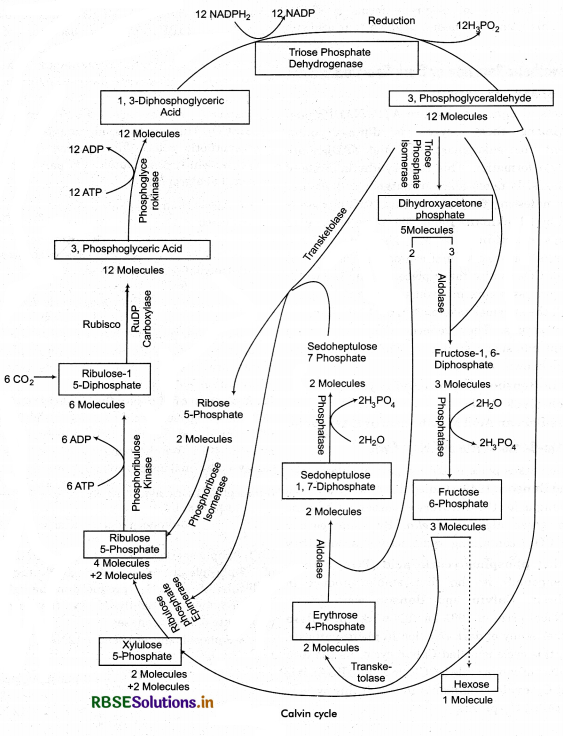
(C) Synthesis of Hexose Sugar:
(iv) Three molecules of phosphoglyceraldehyde combine with three molecules of dihydroxyacetone phosphate (formed in reaction No. 5) to form 3 molecules of fructose 1, 6 - diphosphate. This reaction is catalysed by enzyme alciolase.

(v) 3 molecules of fructose - 1, 6 - diphosphate from 3 molecules of fructose - 6 - phosphate by giving out phosphoric acid in the presence of phosphatase enzyme.

Only one molecule of fructose - 6 - phosphate forms one molecule of hexose sugar (glucose) which forms starch by condensation.
(D) Regeneration of Ribulose Diphosphate:
(i) 2 molecules of 3 - phosphoglyceraldehyde react with 2 molecules of fructose - 6 - phosphate to produce 2 molecules of xylulose - 5 - phosphate and 2 molecules of erythrose - 4 - phosphate. The reaction is catalysed by enzyme transkinase.

(ii) Two molecules of erythrose - 4 - phosphate formed above combine with two molecules of dihydroxyacetone phosphate (formed in the reaction no. 5), to produce 2 molecules of sedoheptulose 1, 7 - diphosphate. It take place in the presence of enzyme aldolase.

(iii) Each molecule of sedoheptulose 1, 7 - diphosphate loses one phosphate group to form sedoheptulose, 7 - phosphate in the presence of enzyme phosphatase. In this reaction, 2 molecules of water also take part and two molecules of phosphoric acid are formed.

(iv) Two molecules of sedoheptulose - 7 - phosphate react with remaining two molecules of 3 - phosphoglyceral - dehyde to form two molecules each of xylulose - 5 phosphate and ribulose 5 - phosphate. This reaction is catalysed by enzyme transketalase.

(v) All the four molecules of xylulose - 5 - phosphate (2 mol formed in the reaction no. 8 and 2 mol. formed in the reaction no. 11) are isomerized to form molecules of ribulose - 5 - phosphate in the presence of enzyme ribulose phosphate epimerase.

(vi) Two molecules of ribulose - 5 - phosphate (Formed in the reaction No. 11) are converted into two molecules of ribulose - 5 - phosphate. This reaction is catalysed by the enzyme phosphoribose isomerase. Therefore, the total of 6 molecules of ribulose 5 - phosphate are regenerated.

(vii) Finally, all 6 molecules of ribulose - 5 - phosphate get phosphorylafed by six molecules of ATP in the presence of enzyme phosphoribulose kinase and regenerate six molecules of ribulose 1, 5 - biphosphate.

In this way, all six molecules of ribulose - 1, 5 - diphosphate are regenerated and then again enter in the cycle.
Use of carbon atoms in Calvin Cycle:
Initially total 36 atoms of carbon enter in Calvin cycle, among them 6 carbon atoms come from CO2 and rest 30 carbon atoms from ribulose biphosphate (5C x 6 RuBP). In glycolytic reversal 6 carbon atoms of CO2 fix into hexose sugar (glucose). Thus 30 carbons remain in different forms.
2 molecules Fructose - 6 - phosphate (6C x 2) = 12 carbons
2 molecules Phosphoglyceraldehyde (3C x 2) = 6 carbons
2 molecules dihydroxyacetonephosphate (3C x 2) = 6 carbons

End Product of Photosynthesis
Phosphoglyceraldehyde can be consider as end product of photosynthesis. But later it converts into different types of sugar such as - glucose, fructose etc. Therefore, hexose sugar is considered as the end product of photosynthesis. Generally hexose sugars store as starch. In some conditions, phosphoglyceraldehyde also form fats and proteins directly or indirectly besides hexose sugars.
In C3 Cycle
1. In - 6 CO2, 18 ATPs, 12 NADPH
2. Out - 1 C6 H12 O6 (glucose), 18 ADPs, 12 NADP

Question 5.
Write a note on Hatch and Slack cycle.
Answer:
Till 1965, it was believed that the fixation of carbon dioxide (CO2) during photosynthesis takes place only by Calvin cycle. But, Kortchak, Hart and Burr in 1965, observed synthesis of oxaloacetic acid (OAA) (a four carbon compound) as first stable product of photosynthesis in sugarcane.
In 1967, M.D. Hatch and C.R. Slack was confirmed the observation given by Hart and Burr. They concluded that in sugarcane, the first stable compound is 4C oxaloacetic acid from which malic acid and aspartic acid are synthesized within a very short time. Later on, such types of observations have been confirmed in many other plants such as maize, jwar, Amaranthes, Atriplex etc. Because in these plants, the fixation of CO2 as first stable compound oxaloacetic acid (4C), therefore, these plants are called C4 plants and the path of CO2 is called C4 cycle. This cycle is also called dicarboxylic acid cycle. The leaves of C4 plants possess special anatomy called Kranz anatomy”. Thie type of anatomy is not found in leaves of dicotyledonous plants.
C4 cycle is completed in mesophyll and bundle sheath cells of leaf. The reduction of CO2 into carbohydrates in C4 plants also takes place by Calvin cycle. The main aim of C4 cycle is to provide sufficient concentration of CO2 for Calvin cycle and this work is done by mesophyll cells. The main steps involved in this cycle are as follows:
In Mesophyll Cell
1. In C4 leaves, the atmospheric CO2, first comes in contact with mesophyll cells, it is accepted by 3 carbon compound, phosphoenol pyruvic acid (PEP). The initial reaction occurs in the cytoplasm of the mesophyll cells where PEP combines with CO2 to form 4 carbon compound oxalic acetic acid (OAA) in the presence of enzyme PEP carboxylase.
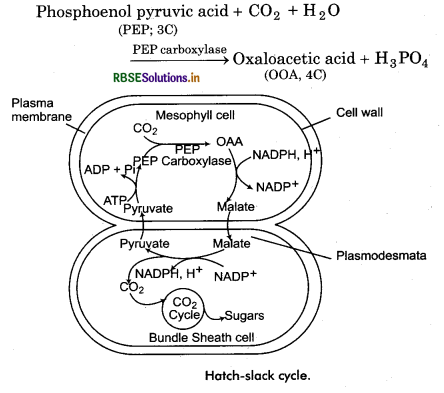
2. Oxaloacetic acid is then transferred to the chloroplast of mesophyll cells and is reduced to malic acid by NADPH2 formed during non - cyclic transport of light reaction. This reaction is catalysed by the enzyme malic dehydrogenase.

In some species of C4 plants oxaloacetic acid is converted to aspartic acid in the presence of enzyme transaminase.
In Bundle Sheath Cells
3. Now malic, acid is transferred to bundle sheath cells. In chloroplasts of bundle sheath cells decarboxylation of malic acid occurs to yield pyruvic acid and CO2. This reaction is catalysed by enzyme malic acid decarboxylase. In this reaction, NADP+ is reduced to NADPH+ H+

4. The carbon dioxide evolved by the decarboxylation of malic acid enters the Calvin cycle and combines with ribulose biphosphate (RuBP) to form phosphoglyceric acid (PGA). Later on it forms carbohydrates through Calvin cycle and RuBP is regenerated.
Again In Mesophyll Cell
5. The pyruvic acid formed in bundle sheath cells by decarboxylation again returns to mesophyll cells. Here, it is converted into phosphoenol pyruvic acid (PEP). In this reaction, one molecule of ATP produced in light reaction is utilized. This reaction is taken place in the presence of enzyme pyruvate phosphate dikinase.

Question 6.
How CO2 fixation takes place in CAM plants?
Answer:
CAM means Crassulacean Acid Metabolism. It is a biochemical process found in succulent plants such as members of family crassulaceae. eg., Kalanchoe, Sedum etc., and some other plants eg., cactus, orchids, pine apple etc. Since the study of this cycle was first made in the members of family crassulaceae, hence, this cycle is called crassulacean acid metabolism (CAM). The plants in which this cycle occurs, are called CAM plants.
Mechanism of CAM Cycle: In CAM plants, stomata open at night, hence, leaves absorb CO2 during night. The phosphoenol pyruvic acid (PEP) present in the cytoplasm of mesophyll cells acts as a CO2 acceptor. It absorbs CO2 to form 4C - compound oxaloacetic acid (OAA). In turn it reduced to malic acid which remains stored in the vacuole of mesophyll cells.
During day time, the malic acid is again return to cytoplasm from the vacuole and decarboxylated to produce pyruvic acid and CO2 is evolved. This process is known as deacidification. Now the CO2 released by deacidificatiqn of malic acid reaches to chloroplast and is reduced to carbohydrates by Calvin cycle. The pyruvic acid is converted into carbohydrates and some amount of it is used in respiration.
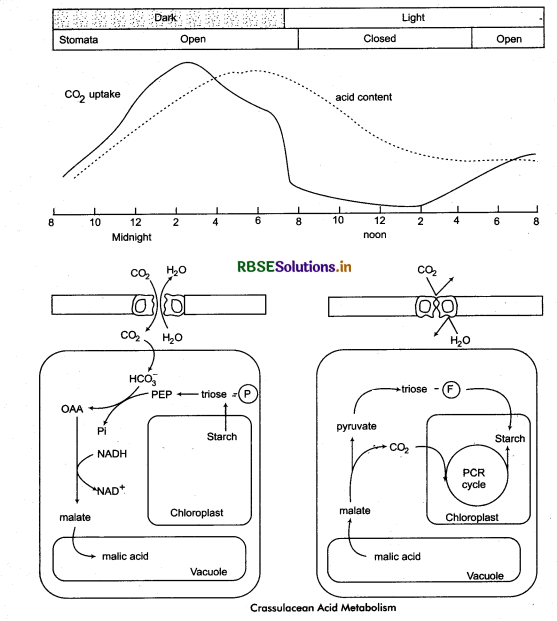

Question 7.
What do you understand by photorespiration? Write the name of cell organelles take part in photorespiration. Explain mechanism of photorespiration.
Answer:
Otto Warburg in 1920, observed in his experiments that there photosynthesis is decreased in green algae in the presence of excessive concentration of O2 in environment. The inhibition of photosynthesis by high O2 level is called Warburg’s effect. This inhibition is found in most of C3 plants. Extensive studies were made to explain Warburg’s effect and these studies led to the discovery of photorespiration.
Generally, plants respire both in light and dark but in some plants such as tobacco, rice, pea etc., the rate of respiration is much more in light than in dark. It is estimated that in green leaves and algae, the rate of respiration in light is 3 - 4 times more than in dark. Therefore the photorespiration is defined as “The respiration that occurs only in light in green cells and responsible for release of extra CO2 is called photorespiration.”
Biochemical Mechanism of Phoforespiration
The study of the mechanism of photorespiration is done in following steps:
1. When there is high concentration of oxygen (O2) or low concentration of carbon dioxide in atmosphere, ribulose - 1, 5 - biphosphate (RuBP) combines with O2 to form one molecule of 3 - phosphoglyceric acid and one molecule of 2 phosphoglyceric acid. This reaction takes place in the presence of enzyme RuBP oxygenase.

2. The 2 - phosphoglyceric acid loses one molecule of phosphate group to get converted into glycolic acid. This reaction is catalysed by enzyme phosphatase. The 3 - phosphoglyceric acid formed in the above reaction enters in the Calvin cycle. Glycolic acid or glycolate is the main metabolic substance for photorespiration which is a 2 carbon compound. Both the above reactions occur in chloroplast.

3. Glycolic acid, produced in chloroplast as an early product of photosynthesis, is then transferred to peroxisomes. Peroxisomes contain oxidase enzyme. Therefore, the glycolic acid and hydrogen peroxide (H2O2). This reaction is takes place in the presence of enzyme glycolate oxidase.

The hydrogen peroxide produced in above reaction is dissociated into water and oxygen by the enzyme catalase.

4. Glyoxylic acid is then converted into glycine (an amino acid) by a reaction transamination. This reaction is catalysed by the enzyme glutamate glyoxylate transaminase.

5. From peroxisome, glycine is transferred into mitochondria. Two molecules of glycine interect to form one molecule each of serine (an amino acid), CO2 and ammonia (NH3).

In photorespiration, the source of CO2 is glycine. This CO2 is released from mitochondria into environment. From mitochondria, ammonia is transferred to chloroplast where it is utilized in the synthesis of glutamic acid.
6. Amino acid serine, returns to peroxisome where it gives its amino group to oxidised glyoxylic acid and itself converted into hydroxy pyruvic acid. The reduction of hydroxy pyruvic acid by NADH forms glyceric acid.
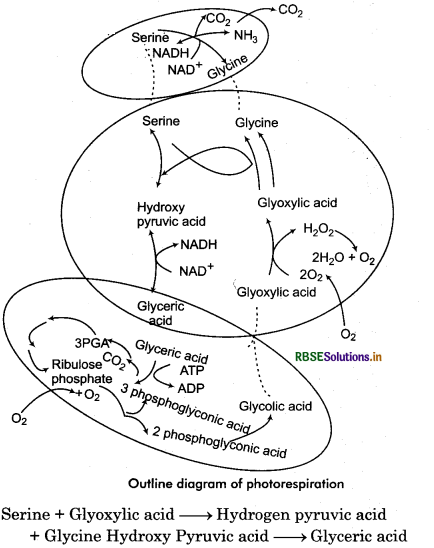
7. Finally glyceric acid is transferred to chloroplast where it is phosphorylated to 3 - phosphoglyceric acid (PGA) which enters the C3 cycle.
Glyceric acid + ATP → 3 - phosphoglyceric acid + ADP + Phosphate
In C3 plants, the process of photorespiration is important for completion of C3 - cycle. In these plants some O2 combine with RUBISCO. Hence CO2 fixation reduces.
Question 8.
Write difference between C3 and C4 pathway.
Answer:
|
C3 Pathway |
C4 Pathway |
|
1. This pathway is found in the leaves of C3 plants because Kranz anatomy is lacking in these leaves. |
1. This pathway is found in the leaves of C4 plants, because leaves possess Kranz anatomy. |
|
2. Only one type of chloroplast are required for this pathway. |
2. Two types (mesophyll and bundle sheath) of chioroplasts are required. |
|
3. In these leaves fixation of CO2 takes place once. |
3. In these leaves fixation of CO2 takes place twice. |
|
4. Primary acceptor of CO2 is ribulose - 1, 5 - biphosphate (RuBP). |
4. Primary acceptor of CO2 is phosphoenol pyruvic acid (PEP). |
|
5. The first table compound of C3 cycle is 3C compound PGA. |
5. The first stable compound of C4 cycle is 4C compound OAA. |
|
6. Less efficient in utilizing CO2. |
6. More efficient in utilizing CO2. |
|
7. Carboxylase enzyme is RuBP carboxylase or RUBISCO. |
7. Carboxylase enzyme is phosphoenol pyruvate carboxylase and RUBISCO. |
|
8. The optimum temperature required for photosynthesis is 20 - 25°C. |
8. The optimum temperature required for photosynthesis is 30 - 45°C. |
|
9. CO2 compensation point is high (25.100 ppm CO2). |
9. CO2 compensation point is low (0 - 10 ppm CO2). |
|
10. Photorespiration occurs which produces phosphog lycolate. |
10. Photorespiration does not occur. |
|
11. It gives low yield. Eg., Tomato, Potato, etc. |
11. It gives high yield. Eg., Sugarcane, Maize etc. |
Question 9.
Write short notes on the following:
(a) Kranz anatomy
(b) Chloroplast.
(c) Chemiosmotic hypothesis.
Answer:
(a) Kranz anatomy: On the basis of internal structure of leaves, C3 and C4 plants can be distinguish separately. The leaves of C4 plant possess Kranz anatomy. In such leaves, the mesophyll is not differentiated into palisade and spongy tissue. In such leaves, the vascular bundle sheath cells are comparatively large in size, more in number and without or less grana, while the chioroplasts of mesophyll cells have well developed grana. Thus chioroplasts in C4 leaves are dimorphic. The enzyme of Calvin cycle are found in bundle sheath cells only.
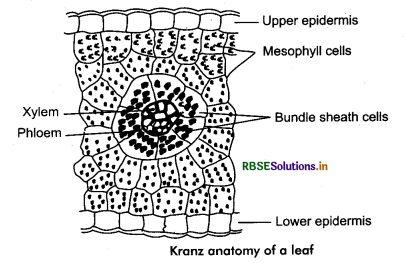
(b) Chloroplast: The process of photosynthesis take place in chloroplast. Chloroplasts are mainly found in mesophyll cells. The mesophyll cell may contains upto 300 hundred chloroplasts. In higher plants, chloroplasts may be oval, spherical or discoid in shape. Chloroplasts mainly found in leaves but they are also present in other parts of plants such as leaf petiole, pedicel, herbaceous stems, calyx and other green parts. They also carry on photosynthesis. But the process of photosynthesis mainly takes place in leaves.
Structure of Chloroplast: In higher plants chloroplasts are disc-shaped or lens-shaped. They are generally 4 - 10 pm in diameter and 1 - 3 pm in thickness. Each chloroplast is surrounded by two unit membrane of lipoprotein which are called outer and inner membranes. These membranes are smooth and selectively permeable. Intermembranous speace is present between these two membranes. There two systems are found inside these membranes called stroma or matrix and grana or lamellar system.
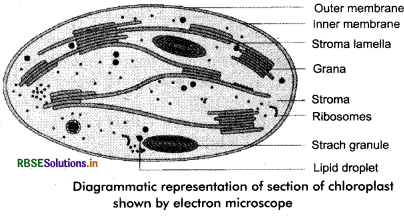
(c) Chemiosmotic hypothesis: According to this theory, molecules like glucose are metabolized to develop acetyl CoA in the form of an intermediate that is energy-rich. The proper oxidation of acetyl CoA occurs in the mitochondrial matrix and is combined to the reduced form of a carrier molecule namely FAD and NAD. The carriers then supply electrons to the transport chain of the electron in the inner membrane of mitochondria, which further supply them to different other proteins present in the ETC. The energy present in the electrons is basically used to pump out protons from the matrix in the inner mitochondrial membrane. It is used for energy storage in the form of a transmembrane electrochemical gradient.
The protons return to the inner membrane by the ATP enzyme synthase. The proton - flow travels into the matrix of mitochondria through ATP synthase, which gets a good amount of energy for the ADP to integrate with inorganic phosphate to produce ATP.
